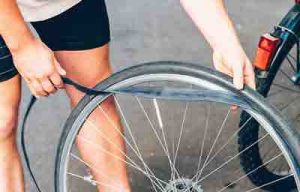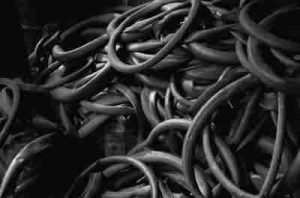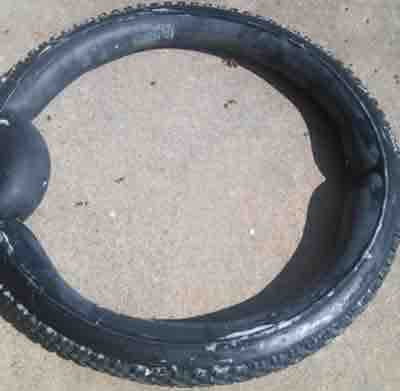For a tire’s inner tubes to pop, it can be that the tire isn’t seated properly due to the wrong installation, or the tire may not fit the tube.
Meanwhile, the tire may look perfectly okay with no holes in it, but the tube is likely to squeeze out somewhere on the rim strip side or between the tire and tube.
This will make the unseated bead allow the trapped tube to inflate, then explode.
This mostly occurs in motorbikes. Are your tires correctly inflated? Soft tires are likely to get “pinch flats” where the tube is pinched by a bump.
It can be caused by a hook that has been damaged; this will destroy the tube beyond repair.
You may have a problem with your rim tape or a sharp nick on your rim that keeps making your inner tubes pop.
Table of Contents
Reasons your inner tubes keeps popping

Having your tire’s tube pop cannot only be inconvenient, but it can also be dangerous sometimes.
But what can be the reasons your inner tubes keep popping?
- High PSI
- Bad tire installation
- Poor inner tube quality
- Pinch flats
- Punctures
- How weather
- Driving long-distance consistently
High PSI
If you take a balloon and fill it until it’s hard, you can effortlessly pop it with the point of a biro, however, if you fill it halfway, the balloon will still be soft, you could poke it severally and it won’t burst.
You will have to apply enough force to make that biro pierce through the balloon. This is very much related to tires; pressures do have a big effect on tires.
At low pressure, the tube will be prone to puncture and when the tube’s pressure becomes high, the risk of a blowout increase; faults in the tire, tube, around the valve, are all likely to exploit.
Bad installation
When changing your tube, make sure you follow the right procedures and do not recklessly damage the tube.
You might end up pinching the tube, this is common in novice users or mechanics, such a mistake will lead you to a deflated tire resulting from your tube popping.
Ensure that you use the right tools when changing the tube, use tire levers, it helps prevent tire pinching.
You can also avoid this issue if you slightly inflate the tube before installation, make sure the tube is properly tucked inside the tire, with no twists or bends.
Poor inner tube quality
Do inner tubes quality matter? Well, yes! Inner tubes do more than just hold the air in your tires.
Quality inner tubes can make your vehicle or bike faster, lighter, and far more prone to punctures while a poor quality inner tube can cause nuisance; making your tube pop frequently.
And because the rolling assistance of your tires is affected by inner tubes, you should purchase a quality one, it is more reliable.
Pinch flats
You were in a hurry on your way home so you bumped hard against a curb, shortly you heard the bang of your tire deflating; you just got a “pinch flat”.
Pinch flats can be incredibly frustrating, this is as a result of the tube being pressed against the wheel rim.
It is also known as snakebites because you’re likely to see two punctures in the tube where it struck the rim.
Punctures
Punctures can be annoying and it’s not possible to completely avoid them as long as you’re using tires with inner tubes.
Generally, punctures are caused by sharp objects poking through the tire and piercing the inner tube.
Most times the object always stays lodged in the tire – if you don’t locate and remove it immediately.
Otherwise, it will find its way to the inner tube and it will quickly burst the tube with the very same little blighter.
That is why it is recommended that you find the area the puncture has damaged, carefully fun your fingers along the inside of the tire.
You might not find anything, but if you do, remove it before it gets to the tube.
Hot weather
Ever blown up a balloon for a party and after two days, that same balloon mysteriously popped by itself, sometimes deflated?
The air you blew inside the balloon did expand it, the air molecules inside the balloon made them bigger. Hooray!
After two days, those air molecules heated up and expanded the balloon even more, “POW” the balloon popped. So sad.
This similarly occurs with tires, when the sun rises, the air in your tires will expand, increasing the internal pressure in your tire which will result in a high level of risk leading to a blowout.
Driving for long-distance
Driving for a long distance at a high speed is a common reason your inner tubes keep popping, as this can result in heat to increase the tire pressure.
The weight and the heat from the road surface contribute to the pressure, making tubes more likely to pop.
How to stop inner tubes from popping

A bit of prevention is worth a thousand cures when it comes to your tires and lifespan.
Unfortunately, getting flats are part of driving and an experience every user may get at some point, but there are some safety guides you can take to reduce this likely occurrence.
Here are (6) expert tips to prevent a tube from popping:
- Watch your tire PSI
- Rotate your tires regularly
- Pick the right inner tubes
- Use talcum powder
- Get quality tires
- Avoid road hazards
Watch your PSI
When you keep your tires inflated within the correct PSI range, it will help keep your tires against pinch flats. Incorrect tire pressure is one of the main reasons why a tire blows out.
You should use a tire pressure gauge to check all tires and your spare also at a minimum of once a month, but you can do so regularly if you would like to.
Before you take your tire’s pressure reading, ensure that your vehicle or bike has cooled off at least a couple of hours
Also, you shouldn’t depend on your vehicle’s TPMS (Tire pressure monitoring system) because the warning light often won’t come when the tire is underinflated.
Therefore, you do not have to rely on this system completely to prevent your tubes from popping or having a flat. Take the time to check your tires yourself.
Rotate your tires regularly
Your tires suffer uneven wear patterns when they are not rotated regularly, when this occurs, the tubes are not left out, the tire will wear down prematurely, requiring replacement sooner than necessary.
Your owner’s manual should serve as a guide to tell you how frequently your tires need to be rotated. The average mile should be between 5000 and 10,000 miles.
A good criterion is to have your tires rotated with every oil change.
Pick the right inner tubes
If you want to use a tire, make sure you also use the right inner tubes, every inner tube has width just like tires do.
If you buy a 25mm whose width is and a 23mm inner tube, there is a possibility that your tube will spread thin because it is trying to expand inside a tire of thinner width.
So, use the right size tube to match the tire to be on the safer side.
Use talcum powder
Just a little bit of talcum powder will go a long way. For cyclists, sprinkle a new inner tube with talcum powder before you install it, this will reduce chafing on the tube’s rubber surface.
This process helps keep the tire and tube from sticking to each other and also lessen friction that may wear a hole in the tube.
Kindly get a locked bag and pour a great amount of the talcum powder in it then simply drop the tube in and give it a good shake.
Doing this will help minimize the use of the powder as it helps not to use the powder unnecessarily.
Get quality tires
Low-quality tires are likely to end up getting flats, your tubes pop often because they’re less durable, less reliable, and also have a shorter lifespan.
It may be quite expensive and may stress a little to source for quality tires but it will stress even more if your tubes keep popping or you end up having a flat tire on a very important day.
Get quality tires and be rest assured.
Avoid road hazards
You should try to avoid hazards on the road as these are some of the ways to prevent your inner tubes from popping.
Although, it can be a bit of a problem trying to avoid road situations such as potholes, nails, sidewalls, and all. However, when this is the case, try as much as possible you avoid driving in such an area.
What to do when your inner tubes keep popping
If you repeatedly keep having your inner tubes ruin, stop patching the tube and get a new tube installed, because a patch is not that strong enough to last as long as a new tube will.
Now, do you wonder how you can then fix a hole in a tube?
Contrary to what we all know; firstly, you have to get the punctured tire put of the tire.
Turn round the bike, take your tire levers and place the lire over the edge of the rim, once the tire is out of the rim, you can pull the tube.
Leave the area around the valve in place check the tube to see where the hole is, you can do this by inflating air into the tube.
Then listen and feel to know where the air is escaping. Make sure to check the tire and take off whatever caused the flat in the first place.
If you see an obvious shard of glass or nail poking out of the tire, gently feel around the tire with your fingers.
You should be careful so that you’ll be satisfied you removed the culprit. There’s nothing more depressing than getting another puncture a few minutes down the road.
Now that you’ve seen the hole in the tube, mark it with a pen or chalk so you don’t lose sight of it, get a small piece of sandpaper and lightly rub around the puncture to give a better surface.
Apply glue to the tube, allow the solution to stay for a few minutes to get tacky. If you add the patch immediately it won’t hold.
Pump a little air into the tube to check if the repair is effective, and to help avoid nipping the tube between the rim and tire.
Push the tube back into the tire and put the tire back on. Be careful not to pinch the tires with the levers, inflate the tire fully and you’re off.
Like I mentioned before, if you repeatedly keep having your inner tube pop, stop patching, kindly get a new tube to guarantee safety and a fast ride.
Are inner tubes that easy to pop?
Yes, inner tubes pop easily when they get thinner as they wear out over time. And just like a balloon, when poked with a pin, it pops.
Likewise a tire, the inner tube holds the air pressure and the tire itself is what covers the tube but when punctured by sharp objects or debris on the road, it will likely pop the tube and cause a flat.
Also, when the tire bead isn’t gripping the rim properly, the bead will slip off the rim when you inflate the tire and resulting in the unseated tube to pop
Inner tubes are usually made of either butyl or latex rubber.
Butyl rubber tunes seem to be the commonest, they’re less expensive than latex, but are heavier and create more rolling assistance with your tires.
Apart from being affordable, another benefit of butyl is that you can quickly do a DIY repair with the necessary tools, so you can certainly get more life out of it than a latex tube.
Latex tubes are significantly lighter than butyl tubes, there’s lower rolling resistance because of less friction against the tire, however, they’re likely to get easily punctured.
They’re more fragile because they’re softer than butyl tubes. Some wheel makers suggest against using latex tubes with their rim because overheating causes latex tubes to fail.
Another disadvantage of latex tubes is that they leak air more easily, you need to pump air up frequently, it’s difficult to repair too when you get a flat.
Whether or not you use a butyl or latex inner tube, your tire tubes are likely to go bad in the useful lifespan.
You should take the preventive measures earlier talked on this article to protect your tires.
You really should stop worrying about why your inner tubes keep on popping.
There’s a piece of glass in there for sure, check the tires, you just had a pinch flat from underinflating or you might have overinflated; check your PSI, or probably you wrongly installed the tube.
For cyclists, make sure the tape covers the holes the spokes go through completely, the spokes might be sticking into the tube.
Nobody says you will never experience a tube popping or a flat tire, ensure to use the aforementioned precautions to reduce your likelihood of getting in such a mess.
Related topics:
- What Causes a Bike Tire to Explode
- Why Does My Bike Tire Look Flat When Riding
- Why are Bicycle Tires Often Inflated to a Higher Pressure

